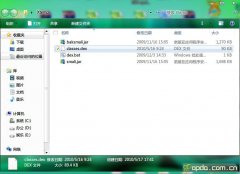Android Looper和Handler分析
第一次接触android应用程序(这里指的是JAVA层的UI程序,也难怪了,Google放出的API就只支持JAVA应用程序了),很难搞明白内部是如何实现的。但是,从原理上分析,应该是有一个消息循环,一个消息队列,然后主线程不断得从消息队列中取得消息并处理之。
然而,google封装得太厉害了,所以一时半会还是搞不清楚到底是怎么做的。本文将分析android内的looper,这个是用来封装消息循环和消息队列的一个类,handler其实可以看做是一个工具类,用来向消息队列中插入消息的。好比是Windows API的SendMessage中的HANDLE,这个handle是窗口句柄。
//Looper类分析
//没找到合适的分析代码的办法,只能这么来了。每个重要行的上面都会加上注释
//功能方面的代码会在代码前加上一段分析
public class Looper {
//static变量,判断是否打印调试信息。
private static final boolean DEBUG = false;
private static final boolean localLOGV = DEBUG ? Config.LOGD : Config.LOGV;
// sThreadLocal.get() will return null unless you've called prepare().
//线程本地存储功能的封装,TLS,thread local storage,什么意思呢?因为存储要么在栈上,例如函数内定义的内部变量。要么在堆上,例如new或者malloc出来的东西
//但是现在的系统比如Linux和windows都提供了线程本地存储空间,也就是这个存储空间是和线程相关的,一个线程内有一个内部存储空间,这样的话我把线程相关的东西就存储到
//这个线程的TLS中,就不用放在堆上而进行同步操作了。
private static final ThreadLocal sThreadLocal = new ThreadLocal();
//消息队列,MessageQueue,看名字就知道是个queue..
final MessageQueue mQueue;
volatile boolean mRun;
//和本looper相关的那个线程,初始化为null
Thread mThread;
private Printer mLogging = null;
//static变量,代表一个UI Process(也可能是service吧,这里默认就是UI)的主线程
private static Looper mMainLooper = null;
/** Initialize the current thread as a looper.
* This gives you a chance to create handlers that then reference
* this looper, before actually starting the loop. Be sure to call
* {@link #loop()} after calling this method, and end it by calling
* {@link #quit()}.
*/
//往TLS中设上这个Looper对象的,如果这个线程已经设过了looper的话就会报错
//这说明,一个线程只能设一个looper
public static final void prepare() {
if (sThreadLocal.get() != null) {
throw new RuntimeException("Only one Looper may be created per thread");
相关新闻>>
- 发表评论
-
- 最新评论 进入详细评论页>>





